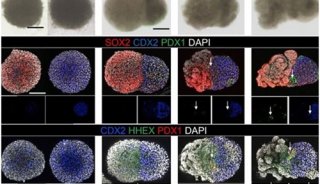在人类诱导多能干细胞衍生皮质神经元(hiPSC-NC)诱导长时..
在人类诱导多能干细胞衍生皮质神经元(hiPSC-NC)诱导长时程增强和抑制现象
Induction of long-term potentiation and depression phenomena in human induced pluripotent stem cell-derived cortical neurons.
A. Odawara, H. Katoh, N. Matsuda, I. Suzuki
Volume 469, Issue 4, 22 January 2016, Pages 856–862
Highlights
•HFS induced LTP and LTD phenomena in hiPSC-derived cortical neurons.
•Spike patterns were generated or disappeared in induction of plasticity.
•hiPSC-derived neurons express the spike pattern with a precise timing change.
•HFS induced L-LTP-like plasticity and the change of synchronized burst firing.
•MEA system is beneficial for clarifying the function of hiPSC-derived neurons.
Abstract
Plasticity such as long-term
potentiation (LTP) and long-term potentiation depression (LTD) in
neuronal networks has been analyzed using in vitro and in vivo
techniques in simple animals to understand learning, memory, and
development in brain function. Human induced pluripotent stem cell
(hiPSC)-derived neurons may be effectively used for understanding the
plasticity mechanism in human neuronal networks, thereby elucidating
disease mechanisms and drug discoveries. In this study, we attempted the
induction of LTP and LTD phenomena in a cultured hiPSC-derived cerebral
cortical neuronal network using multi-electrode array (MEA) systems.
High-frequency stimulation (HFS) produced a potentiated and depressed
transmission in a neuronal circuit for 1 h in the evoked responses by
test stimulus. The cross-correlation of responses revealed that spike
patterns with specific timing were generated during LTP induction and
disappeared during LTD induction and that the hiPSC-derived cortical
neuronal network has the potential to repeatedly express the spike
pattern with a precise timing change within 0.5 ms. We also detected the
phenomenon for late-phase LTP (L-LTP) like plasticity and the effects
for synchronized burst firing (SBF) in spontaneous firings by HFS. In
conclusion, we detected the LTP and LTD phenomena in a hiPSC-derived
neuronal network as the change of spike pattern. The studies of
plasticity using hiPSC-derived neurons and a MEA system may be
beneficial for clarifying the functions of human neuronal circuits and
for applying to drug screening.
神经可塑性如长时程增强(LTP)和长时程增强抑制(LTD)在神经网络中的机制,及种种关于学习、记忆,及发育等脑功能发展已通过不同动物模型,使用离体和载体等技术来分析研究。人类诱导多能干细胞衍生的神经元(hiPSC-NC)可以有效地用于理解人类神经网络的可塑性机制,从而阐明疾病发病机制和帮助药物研发。在这项研究中,日本东北工业大学的研究人员试图采用多电极阵列(MEA)系统在培养的hiPSC皮层神经元诱导LTP和LTD现象。高频刺激(HFS)在神经元电路产生一组长达一小时的增效和抑制传递的诱发反应。相关的相应反应显示,具有特别时间值的峰电位模式在LTP的诱导中产生,并于LTD诱导中消失,hiPSC-衍生的皮质神经元网络有可能重复地表达该峰电位,时间精确度可达到0.5
ms内。研究人员也检测到类似可塑性的后期LTP现象(L-LTP)和类似HFS的自发电位发射中的同步簇状发射(SBF)的结果。研究人员观察到在hiPSC衍生的神经元网络的LTP和LTD现象伴随峰电位模式变化。使用hiPSC衍生神经元和MEA系统可帮助研究人员研究人类神经元电路的功能和药物筛选的可塑性研究。
原文链接:http://www.sciencedirect.com/science/article/pii/S0006291X15310925
-
项目成果









